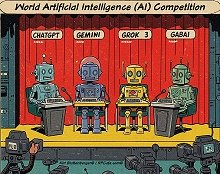Electronics & High Technology Components
- See Full List of AI Topics -

A selenium rectifier is a type of rectifier that uses selenium as a
semiconductor material to convert alternating current (AC) to direct current
(DC). Selenium rectifiers were commonly used in electronics applications during
the mid-20th century, but they have since been largely replaced by other types
of rectifiers such as silicon rectifiers.
A selenium rectifier element refers to the selenium wafer or disc used as the
rectifying material in a selenium rectifier. The element typically consists of a
cylindrical or disc-shaped piece of selenium that is sandwiched between two
metal plates or electrodes. When an AC voltage is applied across the electrodes,
the selenium element acts as a semiconductor and allows current to flow in only
one direction, effectively rectifying the AC signal into a DC signal.
Selenium rectifiers have several advantages over other rectifier types, such
as high reliability, long lifespan, and low cost. However, they also have some
drawbacks, including relatively low efficiency and the potential release of
toxic selenium compounds when the rectifier is heated or damaged. As a result,
selenium rectifiers are now mostly obsolete and have been replaced by more
efficient and safer rectifier technologies.
Selenium is a chemical element with the atomic number 34, and it is a
non-metal in the periodic table. Here are some of the properties of selenium:
Physical properties: Selenium is a grayish-black, brittle solid at room
temperature, with a metallic luster. It has a melting point of 217 degrees
Celsius and a boiling point of 684 degrees Celsius.
Chemical properties: Selenium is a relatively reactive element that readily
combines with other elements to form compounds. It is also a good conductor of
electricity and can act as a semiconductor when doped with impurities.
Selenium is found naturally in the Earth's crust, often in association with
sulfur, and it is widely distributed in rocks, soils, and water. It is also a
byproduct of the refining of certain metals, such as copper and lead.
To process selenium for use in electronic components, such as rectifiers, the
element is first extracted from its ores and purified through a series of
chemical and physical processes. The resulting purified selenium is then shaped
into the desired form, such as wafers or discs, and assembled into the rectifier
components.
There are some potential dangers associated with selenium, especially when it
is in its elemental form. Exposure to high levels of selenium can cause a range
of health effects, including respiratory irritation, gastrointestinal
disturbances, and neurological symptoms. Selenium can also be toxic to aquatic
life and can accumulate in the food chain, so proper handling and disposal of
selenium-containing materials are important to minimize environmental impacts.
Despite the potential risks associated with selenium, it has a variety of
important industrial and technological uses. In addition to its use in
rectifiers, selenium is used in photovoltaic cells, glassmaking, pigments, and
animal feed supplements. It is also a trace element that is essential to human
health in small amounts.
 This content was generated by primarily
the ChatGPT (OpenAI), and/or
Gemini (Google), and/or
Arya (GabAI), and/or
Grok 3 (x.AI) artificial intelligence (AI) engine.
Some review was performed to help detect and correct any inaccuracies; however,
you are encouraged to verify the information yourself if it will be used for critical
applications. In some cases, multiple solicitations to the AI engine(s) was(were) used to assimilate
final content. Images and external hyperlinks have also been added occasionally.
Courts have ruled that AI-generated content is not subject to copyright restrictions,
but since I modify them, everything here is protected by RF Cafe copyright. Many
of the images are likewise generated and modified. Your use of this data implies
an agreement to hold totally harmless Kirt Blattenberger, RF Cafe, and any and all
of its assigns. Thank you. Here are the major categories. This content was generated by primarily
the ChatGPT (OpenAI), and/or
Gemini (Google), and/or
Arya (GabAI), and/or
Grok 3 (x.AI) artificial intelligence (AI) engine.
Some review was performed to help detect and correct any inaccuracies; however,
you are encouraged to verify the information yourself if it will be used for critical
applications. In some cases, multiple solicitations to the AI engine(s) was(were) used to assimilate
final content. Images and external hyperlinks have also been added occasionally.
Courts have ruled that AI-generated content is not subject to copyright restrictions,
but since I modify them, everything here is protected by RF Cafe copyright. Many
of the images are likewise generated and modified. Your use of this data implies
an agreement to hold totally harmless Kirt Blattenberger, RF Cafe, and any and all
of its assigns. Thank you. Here are the major categories.
Electronics & High Tech
Companies | Electronics &
Tech Publications | Electronics &
Tech Pioneers | Electronics &
Tech Principles |
Tech Standards Groups &
Industry Associations | Societal
Influences on Technology
|










